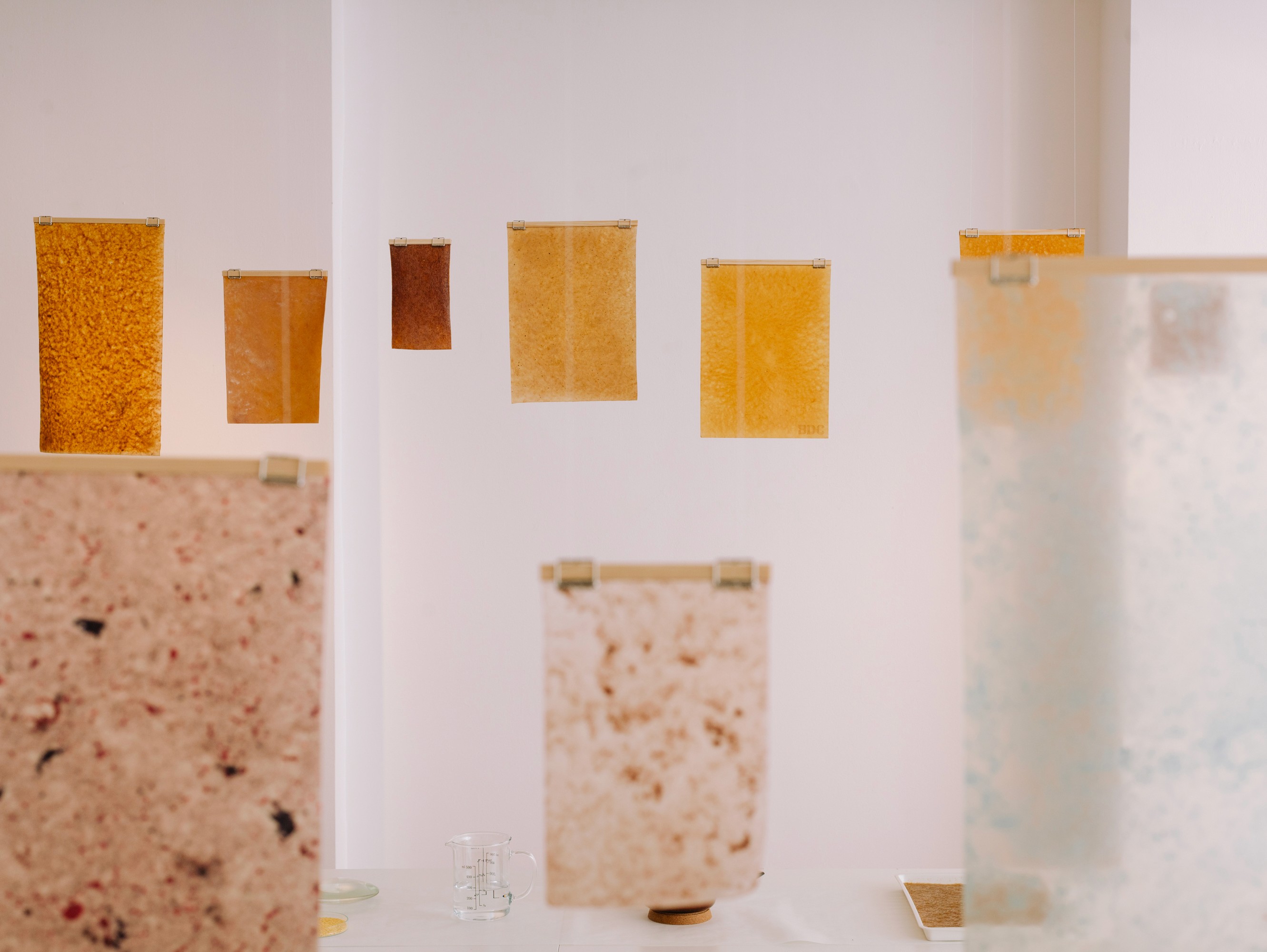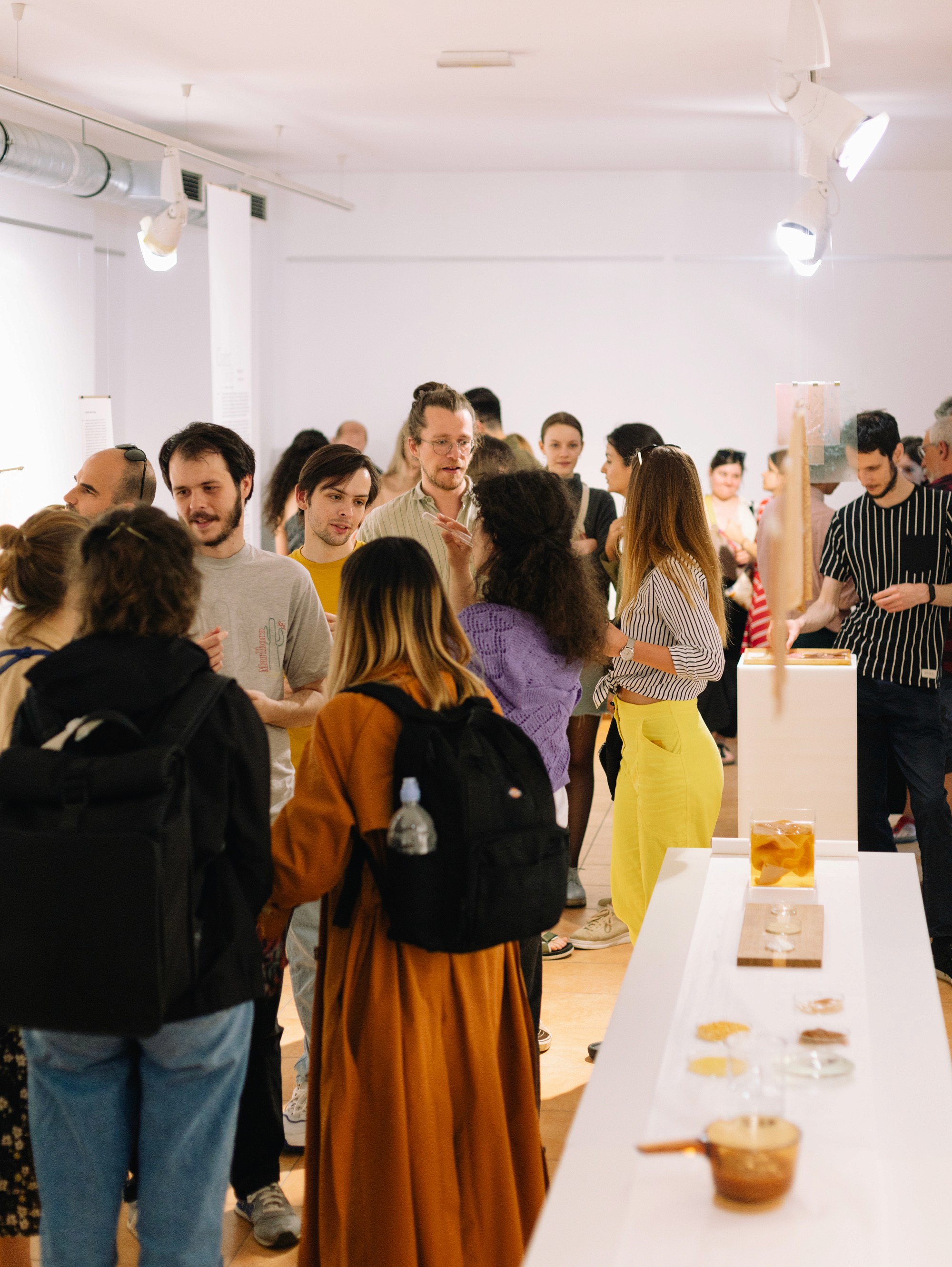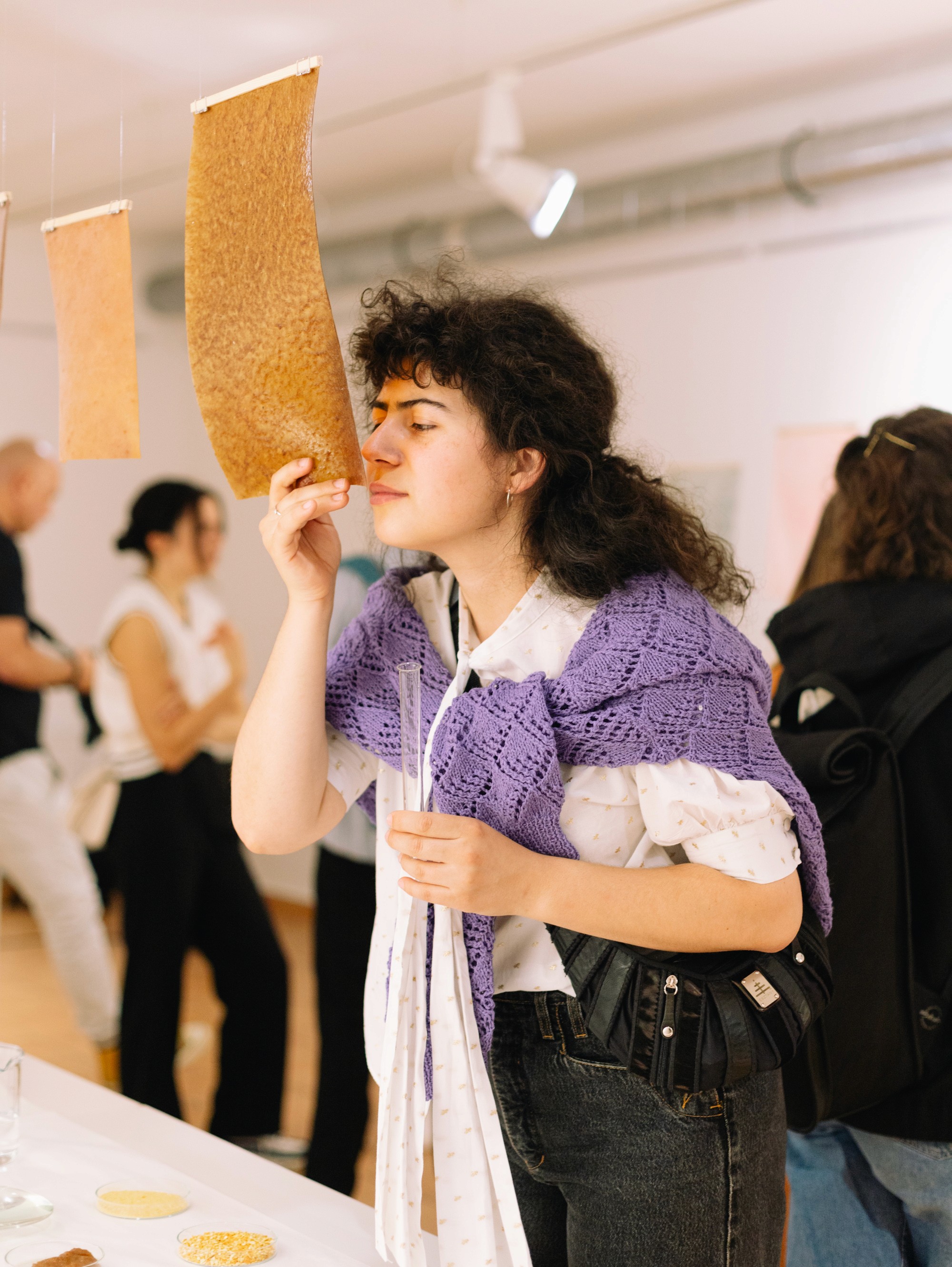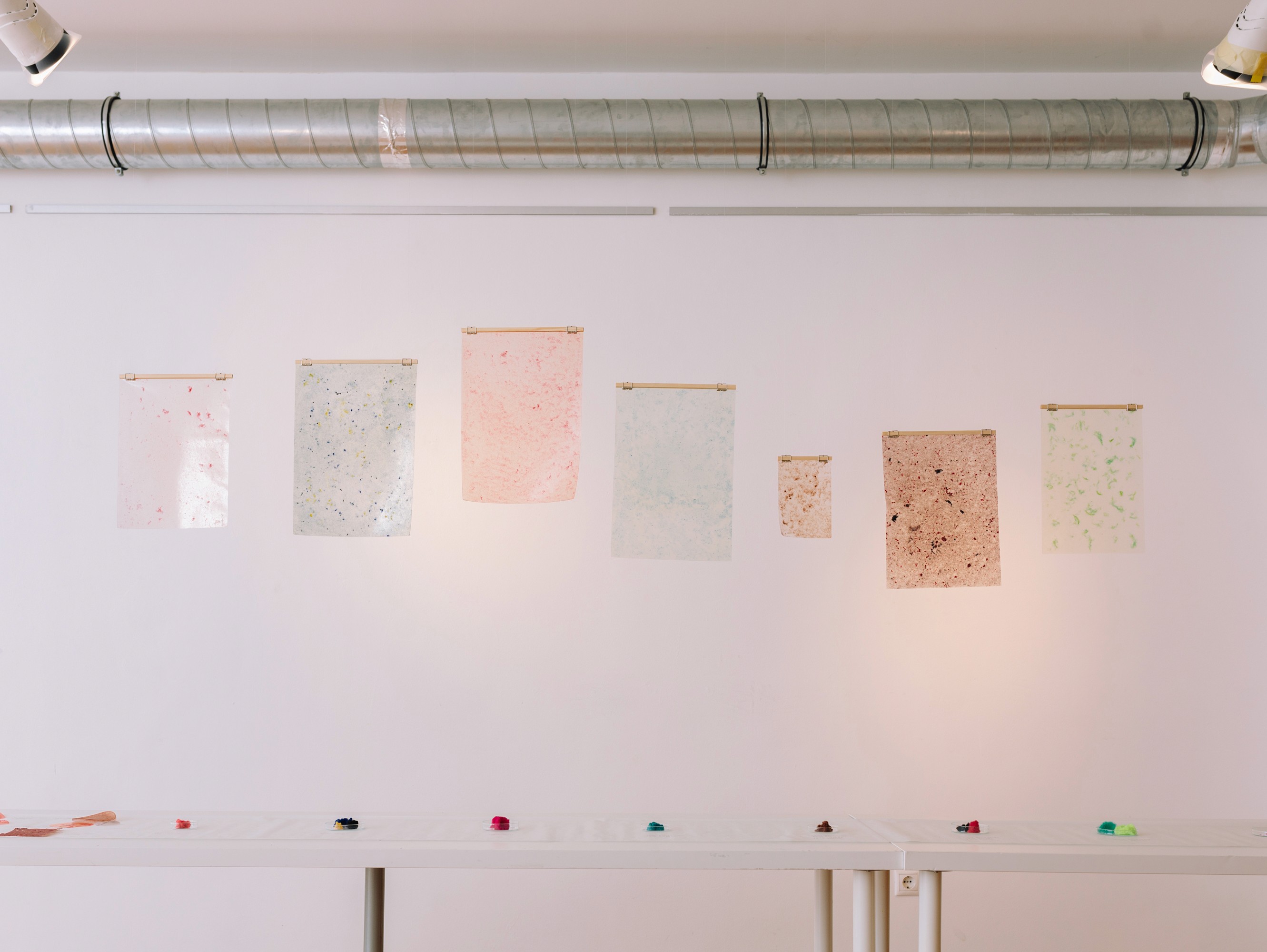A vizet melegíteni kezdjük, majd a glicerint és a zselatint forráspont előtt belekeverjük. A folyadékot csomómentesre dolgozzuk és hozzáadunk egy csipetnyi pink pulóverszöszt. Ha összeállt, a mixtúrát formába öntjük és árnyékos helyen hűtjük. Másnap már felhasználható! De hogy pontosan mire? Ezzel és más, a bioplasztikok előállítását övező kérdésekkel foglalkozik a Cooking Plastic kiállítás, amelyen Harsány Patrícia ékszertervező anyakísérleteivel találkozhatunk egy interaktív installációs környezetben.
Harsány Patrícia általában az újrahasznosítás és a kisajátítás gyakorlatait alkalmazza, így született tárgyai az ékszer fogalmi határait kérdőjelezik meg. Legújabb kiállítása rendhagyó, hiszen nem a tőle megszokott tárgyakat vagy ékszerhelyzeteket láthatjuk, hanem kísérleti anyagmintákat – ezzel a tervező bepillantást enged a tárgyalkotás legelső fázisába. Harsány Patrícia az év elején három hónapot töltött a Basque BioDesign Centerben, ahol különböző bioplasztik anyagok receptjeit kutatta, melynek eredményeit most a K11 LABOR konyhává alakult kiállítóterében összegzi.
A bioplasztik, illetve a textilhulladékokból létrejött szintetikus anyagok készítése leginkább a főzésre, mint kreatív alkotói és gondolkodási folyamatra hasonlít – az arányok kikísérletezése, a receptek lejegyzése és a felhasznált segédeszközök mind a jól ismert konyhai folyamatokat idézik fel. Csakúgy, mint a zero-waste főzés, a bioplasztikok és az upcycling matériák előállítása is az „abból főzzünk, amink van” elvét követi: célja, hogy olyan alapanyagokkal dolgozzunk, melyek kis ökológiai lábnyommal rendelkeznek és amelyekre korábban szemétként tekintettünk.
A kiállítási anyagok a Basque BioDesign Center támogatásával jöhettek létre.
____
Heat the water, then add glycerin and gelatin before it reaches the boiling point. Mix until it becomes smooth and add a pinch of pink sweater bobbles. Pour the mixture into a mould and let it cool in a dark place. The next day it will be ready to use! But what exactly is it for? Cooking Plastic tries to answer this along with other questions surrounding the production of bioplastics. At the exhibition, visitors can observe material experiments in an interactive installation environment by Patrícia Harsány jewellery designer.
Patrícia Harsány typically uses the practice of recycling and appropriation to make her works and by doing so, her creations challenge the conceptual boundaries of jewellery. Cooking Plastic is an exceptional show from the designer because instead of her usual objects, we can see experimental material samples. This allows her to offer insight into the first phase of making an object. At the beginning of the year, Patrícia Harsány spent three months at the Basque BioDesign Center, where she researched and created recipes for various bioplastic materials, and now she summarizes the results in the exhibition space K11 LABOR which, for this show, has transformed into a kitchen.
Experimenting with proportions, recording recipes, and using cookware – to create bioplastics and material samples resembles the practice of cooking as a creative thinking method. Like zero-waste cooking, the production of bioplastics and upcycling materials follows the principle of "cooking with what we have." It aims to work with ingredients that have a low ecological footprint or with ingredients that were previously considered waste.
The materials were created with the support of the Basque BioDesign Center.
A vizet melegíteni kezdjük, majd a glicerint és a zselatint forráspont előtt belekeverjük. A folyadékot csomómentesre dolgozzuk és hozzáadunk egy csipetnyi pink pulóverszöszt. Ha összeállt, a mixtúrát formába öntjük és árnyékos helyen hűtjük. Másnap már felhasználható! De hogy pontosan mire? Ezzel és más, a bioplasztikok előállítását övező kérdésekkel foglalkozik a Cooking Plastic kiállítás, amelyen Harsány Patrícia ékszertervező anyakísérleteivel találkozhatunk egy interaktív installációs környezetben.
Harsány Patrícia általában az újrahasznosítás és a kisajátítás gyakorlatait alkalmazza, így született tárgyai az ékszer fogalmi határait kérdőjelezik meg. Legújabb kiállítása rendhagyó, hiszen nem a tőle megszokott tárgyakat vagy ékszerhelyzeteket láthatjuk, hanem kísérleti anyagmintákat – ezzel a tervező bepillantást enged a tárgyalkotás legelső fázisába. Harsány Patrícia az év elején három hónapot töltött a Basque BioDesign Centerben, ahol különböző bioplasztik anyagok receptjeit kutatta, melynek eredményeit most a K11 LABOR konyhává alakult kiállítóterében összegzi.
A bioplasztik, illetve a textilhulladékokból létrejött szintetikus anyagok készítése leginkább a főzésre, mint kreatív alkotói és gondolkodási folyamatra hasonlít – az arányok kikísérletezése, a receptek lejegyzése és a felhasznált segédeszközök mind a jól ismert konyhai folyamatokat idézik fel. Csakúgy, mint a zero-waste főzés, a bioplasztikok és az upcycling matériák előállítása is az „abból főzzünk, amink van” elvét követi: célja, hogy olyan alapanyagokkal dolgozzunk, melyek kis ökológiai lábnyommal rendelkeznek és amelyekre korábban szemétként tekintettünk.
A kiállítási anyagok a Basque BioDesign Center támogatásával jöhettek létre.
____
Heat the water, then add glycerin and gelatin before it reaches the boiling point. Mix until it becomes smooth and add a pinch of pink sweater bobbles. Pour the mixture into a mould and let it cool in a dark place. The next day it will be ready to use! But what exactly is it for? Cooking Plastic tries to answer this along with other questions surrounding the production of bioplastics. At the exhibition, visitors can observe material experiments in an interactive installation environment by Patrícia Harsány jewellery designer.
Patrícia Harsány typically uses the practice of recycling and appropriation to make her works and by doing so, her creations challenge the conceptual boundaries of jewellery. Cooking Plastic is an exceptional show from the designer because instead of her usual objects, we can see experimental material samples. This allows her to offer insight into the first phase of making an object. At the beginning of the year, Patrícia Harsány spent three months at the Basque BioDesign Center, where she researched and created recipes for various bioplastic materials, and now she summarizes the results in the exhibition space K11 LABOR which, for this show, has transformed into a kitchen.
Experimenting with proportions, recording recipes, and using cookware – to create bioplastics and material samples resembles the practice of cooking as a creative thinking method. Like zero-waste cooking, the production of bioplastics and upcycling materials follows the principle of "cooking with what we have." It aims to work with ingredients that have a low ecological footprint or with ingredients that were previously considered waste.
The materials were created with the support of the Basque BioDesign Center.
Kiállító/Exhibiting artist:
HARSÁNY Patrícia
Kurátor/Curator:
VISKI Noémi
Dátum/Date:
2023. 06. 14 – 07. 04.
Megnyitó/Opening:
2023. 06. 13. 19:00
Megnyitotta/Opened by:
–
Fotók/Photos:
GAÁL Dániel
Közreműködők/Contributors:
HÁLÓ Veronika Róza (installáció/installation); UMLAUF Adrienn (grafika/ graphic design)








